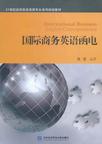国际商务英语函电
出版时间:2011-8 出版社:对外经济贸易大学出版社 作者:吴雯 页数:272
内容概要
《国际商务英语函电》按国际贸易流程以一笔鞋子交易为主线展开,根据工作流程呈现了order
inquiry(客户询盘),container
loading(装柜要求)等公司信函实例,每个环节收进了业务常用的最新术语与词汇,例如OEM,MOQ,leading
time,HQ,TNT,Pay
bal等,并分环节对国际贸易语言点进行介绍。其次《国际商务英语函电》表格形式多,有询盘单、报价单、估价单、装船通知等,新颖实用。练习题结合了托业考试的最新题型,实训内容紧跟业务员的实际操作,附有公司真实信头、名片、图片等,实现了与外贸业务零距离的接触,从多方面训练学生的贸易实战能力。
书籍目录
Module I International Business English Correspondence
Basics
Chapter I International Business English Corresp Ondence
Basics
I.An Introduction to the Course
II.Guidelines for Effective Business Correspondence
III.Layout of Business Letters&E-mails
Skill Training
BUSiness Link
Module II Establishing Business Relations
Chapter II Establishing Business Relations
Lesson l About Us
Lesson 2 Self-introduction
Lesson 3(A)A First Inquiry
(B)Reply to the Above
Skill Training
Business Link&Useful Sentences
Module III Business Negotiations
Chapter III Inquiry and Reply
Lesson 4(A)General Inquiry
(B)Reply to the Above
Lesson 5 An Order Inquiry
Lesson 6(A)Status Inquiry
(B)Reply to the Above
Skill Training:
Business Link&Useful Sentences
Chapter IV Samples and Charges
Lesson 7(A)Asking for Samples
(B)Reply to the Above
Lesson 8(A)Refusing to Pay Sample Charges
(B)Reply to the Above
Lesson 9(A)Sending Samples
(B)Sending Duplicate Samples
Skin Training
Business Link&Useful Sentences
Chapter V Offers and Counter-Offers
Lesson 10 A Firm Offer
Lesson 11(A)A Counter Offer
(B)Reply to the Above
Lesson 12(A)New Price for Repeat Order
(B)Reply to the Above
Skill Training
Business Link&Useful Sentences
Module IV Execution of Contracts
Chapter VI Orders and Contracts
Lesson 13 A Purchase Order
Lesson 14(A)Partial Acceptance ofan Order
(B)Reply to the Above
Lesson 15(A)Sending a Sales Confirmation
(B)Counter-Signature Letter
Skill Training
Business Link&Useful Sentences
Chapter VII Payment
Lesson 16(A)Asking for Payment by T/T
(B)Confirming Payment by T/T
Lesson 17 Declining Payment by 60 Days L/C
Lesson 1 8(A)Asking for Easier Payment
(B)Reply to the Above
Skill Training
Business Link&Useful Sentences
ChapterⅥII Establishment of and Amendment to L,C
Lesson 19(A)Urging Establishment ofL/C
(B)Confirming L/C Application
Lesson 20(A)Amendment to L/C
(B)Reply to the Above
Lesson 21(A)Asking for Extension ofL/C
(B)Reply to the Above
Sklll Training
Business Link&Useful Sentences
Chapter IX Packing&Marking
Lesson 22 Inner Packing&Labeling
Lesson 23 Outer Packing
Lesson 24 Container Loading
Skill Training
BUSiness Link&Useful Sentences
Chapter X Shipment
Lesson 25(A)Shipping Instructions
(B)Reply to the Above
Lesson 26(A)Requesting for Prompt Shipment
03、Reply to the Above
Lesson 27 Requesting for Transhipment and Partial Shipments
Skill Training
Business Link&Useful Sentences
Chapter XI Insurance
Lesson 28 Insurance Information
Lesson 29 Asking for CIF Terms
Lesson 30(A)Inquiring for Insurance Rate
(B)Offering Insurance Rate
Skill Training
Business Link&Useful Sentences
Chapter XII Complaints.Claims and SeUlement
Lesson 3 1 Complaint about Inferior Quality
Lesson 32 Claim on Late Delivery
Lesson 33 Settlement ofComplaint
Ski11 Training
Business Link&Useful Sentences
Module V Documents
Chapter XIII Specimen of Documents
Skill Training
Appendix I国际机构
Appendix II国际展会列表
Appendix III世界各大船公司名录
参考书目
章节摘录
The major advantage of collection is the low cost, compared with an L/C. However, thisis offset by the risk that the importer might for some reason or other reject the documents. Since the cargo would have already been loaded, the exporter has little recourse against theimporter in cases of non-payment. Therefore the D/A or D/P arrangements involves a highlevel of trust between the exporter and the importer. The fundamental difference between letter of credit and collection arrangements is thatthe former is bankers' credit, under which the bank is fully responsible for payment as long asthe buyer has done exactly what is prescribed under the L/C; the latter is commercial credit, under which banks only act as agents to collect payment form the drawee of the bill ofexchange. Banks bear no responsibility if the buyer dishonors (refuses to pay) the bill. Therefore whether the seller can get payment all depends on the creditworthiness andco mmercial integrity of the buyer. 3. Remittance As the simplest method of payment in international trade, remittance means that the payer(usually the buyer) remits a certain sum of money in accordance with the parties' agreement tothe payee (usually the seller) through a bank. This method of payment is often used for downpayment, payment of commission and for sample, settlement of claim, or as performance bond,etc. Based on the means of transferring funds, a remittance usually falls into the foll owingthree types: a. Mail Transfer (M/T) b. Telegraphic Transfer (T/T) c. Demand Draft (D/D) Mail transfer and telegraphic transfer both refer to the movement of money from onebank account to another and differ in that the former is made by airmail while the latter bycable, telex or SWIFT. Mail transfer is cheap but slow, so it is typically used for remittances ofsmall sums or of little urgency. While telegraphic transfer is safe and fast, thus it is currentlythe most popular way of remitting funds. Demand draft is a draft drawn by the importer's bank on its branch or correspondent bankin the exporter's country and is payable immediately the exporter or holder demands payment.Thus, the procedures of demand draft are quite different from M/T and T/T, and it is alsocalled reverse remittance. Such a demand draft is a type of bills of exchange. This means thatthe payee can transfer the draft before it is presented to the paying bank for payment. T/T andM/T do not have the same property as D/D. Time of payment is also an important aspect for a sales transaction. It may be earlier orlater than, or the same as the time of delivery. ……
图书封面
评论、评分、阅读与下载
用户评论 (总计3条)
- 这本函电编写的很不错
- 体育健健康康勘校经籍呵呵
- 书本看起来很不错呢
